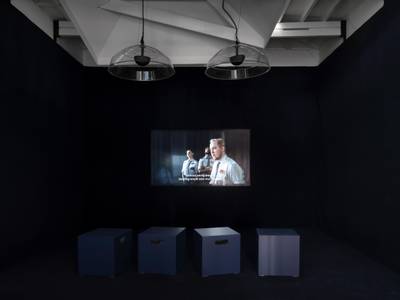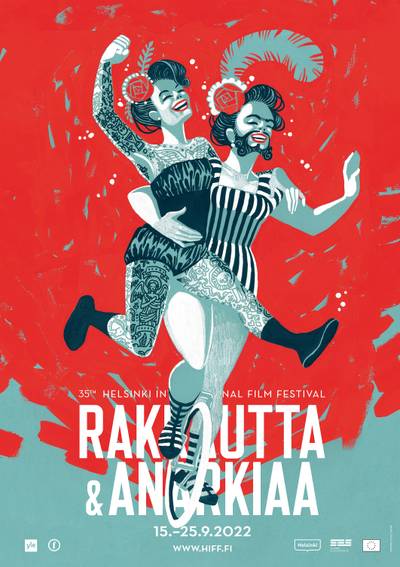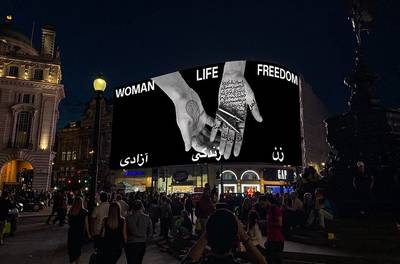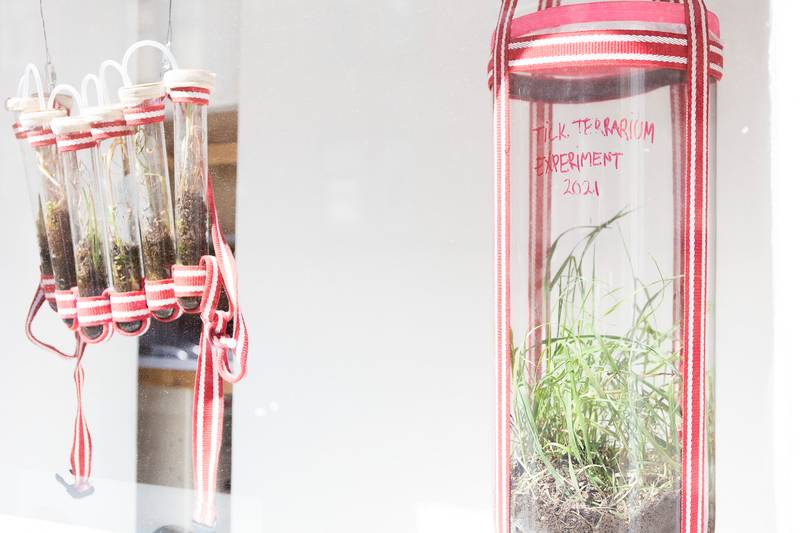

Laura Beloff, Tick Terrarium 2020 (TICK ACTs), SOLU Space, May 2021. Photo courtesy Mari Kaakkola.
Yvonne Billimore is an artist-curator moving between Helsinki and Scotland. Yvonne is associate curator of Rehearsing Hospitalities, Frame Contemporary Art Finland’s public programme for 2019 to 2023. Previously, she was the Programme Manager at Scottish Sculpture Workshop in rural Aberdeenshire, where she developed and produced a programme of international residencies and projects, alongside workshops and public events.
Reflections on encountering and thinking-with “other” bodies through art.
tick, tick, tick, tick, tick, tick, tick, tick, tick, tick, tick, tick, tick
tick. tick. tick.
tick… tick… tick… pulsing. pulsing.
breathe in and breathe out.
I’m in my body
attention/awareness
bodily.
voices that are not my “own” seep in
unfamiliar/unknown/un-nerving
/or the effects of alienation from my own internal sonic beats, rhythms, flows,
to whom do these vibrations belong? me; an-other: both of us in intra-action?
“mixed oddities”
porous bodies singing together
tick, tick, tick, tick, tick, tick, tick, tick, tick, tick, tick, tick, tick
… skin crawling!
touch down,
back to my body through my fingertips
/with
ocular touch,
/with “fingeryeyes” like the tips of a tick’s legs.
sensual hand strokes situate and sooth,
/with whispers from an-other stroking my thoughts,
feasting upon
the un-contain-ability of the body,
microbial bodies,
multi-body pluralities,
bodies conjoining &
breaking the peripheries of skin.
1
As I approach Bioart Society’s SOLU space I am greeted at the door by artist Kira O’Reilly who acts as the host for her and artist Laura Beloff’s two-day exhibition TICK ACTs2. Entry is one at a time, so I booked a spot online the evening before. Living in times of a viral pandemic, it’s comforting to be welcomed to be an audience of one, but more than simply a safety measure, this form of hospitality feels fitting for sharing this body of work—and hosting a performance for one or small numbers has a long history in O’Reilly’s work. To be received by the artist, to be held by their presence and attentively guided into and through the work, in a personalised performance feels timely. After a long period of self-containment and social isolation— protecting each other and ourselves through reducing contact—this personalised care and shared intimacy with another feels like tending wounds. As a guest, you are “hand-guided” through artworks dealing with uncomfortable “subjects”, ones that puncture our boundaries and explicate the uncontainability of our bodies and interdependencies with others.
Unable to remember the visiting time I had booked, I arrived at SOLU late, hot and flustered! I was met with an air of calmness and guided into the space. Through the door and down a couple of steps, the space rests slightly below street level. White, bright and empty, it feels distinctly sterile. A bare room with a rocking chair in the centre for holding a body and rocking it gently. An unwelcoming space instantly transformed through the presence of this chair that embodies security, safety and comfort. It is the perfect gesture of hospitality for an artwork conceived to encounter and counter potential threat(s). Gifted with a media player, headphones and instructions, I sit back and press play. My host exits the room through a curtain, assuring me she is there should I need her. Into the chair and my body, I sink.
Arachnid - Tick sensing by Kira O’Reilly and Antye Greie (AGF) is a sound work composed of multi-layered texts, sounds, pulsating beats and guided meditative actions.3 Antye Greie is responsible for creating the sound and compositional elements of this work which seem to take on a life of their own: ticking, whispering and transmitting on different frequencies. The spoken text oscillates between essay form, poetic provocations, definitions and scientific facts, all artfully delivered through Kira O’Reilly’s sensual tones. The work spins you off in different directions, disorientating you with dense information and alien-like interferences, then draws you back into your own body through a soothing mantra that repeats throughout: “breathe in and breathe out … allow thoughts to subside … and gentle awareness to occupy your periphery and atmosphere with no sense of concept and only that of sensation.” 4
Kira O’Reilly is an interdisciplinary artist, perhaps most celebrated for her contributions to the fields of performance and live art, she is also well known for her involvement in Bioart and working with living materials and entities. The sensibilities of the latter have been affecting her practice as a whole for over twenty years. At the core of O’Reilly’s practice is working with and troubling the concept of “The Body”, including its limits, boundaries, uncontainability, unfixity, pluralities and its entanglement with other bodies—human, more-than-human, living and non-living. Whatever the discipline, O’Reilly employs a considerable sensitivity to her materials, and in this sound work, performative writing is no exception. Language is the method and material of Arachnid - Tick sensing. It is thick yet elastic, playful, evocative, vibrant and visceral. As the words ring in your ears, you can feel them in your mouth, expanding and contracting, pulsating. Each bulbous mouthful perhaps closer to smelling than tasting.
O’Reilly’s long founded commitment to and knowledge of working with the body, performance and performativity, plays a crucial role in this work—her awareness and sensitivity of bodies is deeply present. It shows through her ability to guide you into your own body, then to the body of an-other, back to your own body, and somewhere in between not quite one or the other.
Language has the power of transformation and combined with the “uncanny sonic textures” developed by Greie, the work comes alive and almost hypnotic. It’s enticing, seductive, even erotic. Initially I squirm, skin crawling, as tick facts and speculative theories are recited to me, strange alien sounds echoing in the background … but then … repulsion and fear turn to intrigue. I am lured into shifting my mindset to that of the tick, before it clicks that it is I lustfully feasting on the body of an-other. I, the potential host, have become the hosted. I entertain the notion when I become conscious of becoming tick, choosing quite happily to stay latched on exchanging my enzyme laced saliva for warm blood. This fluid exchange is more than survival; it is pleasure.
When I come “back to my senses”, I am surprised at myself (someone who became vegetarian at the age of twelve over a bloody steak and never turned back). The experience gets under my skin, like the first time I read Octavia Butler’s short story Bloodchild; it disturbs me, stays with me: a whole host of questions to unpack about myself, others and our relations in the world together. Arachnid - Tick sensing doesn’t invite you to enact anthropomorphisation—the attribution of human characteristics to non-human others—rather the reverse. Like a good science fiction story, it takes you beyond what you think you know. It shifts your perspective for a moment to consider the world from the body of an-other.
O’Reilly’s long founded commitment to and knowledge of working with the body, performance and performativity, plays a crucial role in this work—her awareness and sensitivity of bodies is deeply present. It shows through her ability to guide you into your own body, then to the body of an-other, back to your own body, and somewhere in between not quite one or the other. Hosted in this way, you enter into a sensorial performance of your own. This is clearly the intention of the work: to create lively, unexpected encounters between your body and those of others.
I want art to be a place and process to think-with. I find it limiting to purely interpret meaning or figure out “what is the artist trying to say?”. And actually, I find this emphasis on “knowing” makes the world of art and culture highly inhospitable and alienating for many. I want the possibility to meet with art, to bring myself into the work—with my unique assemblage of knowledge, experiences, relations, and identities that shape how I move and interact with the world—and through this engagement create something with the art/artist. Something that affects me. Artworks can help us grapple with complex and unresolved questions we have about the world, sometimes complicating them even further, and rather than providing answers, can provoke more questions. This is precisely the beauty of O’Reilly and Greie’s sound work; it presents unfamiliar perspectives, but rather than provide reductive answers, it encourages us to ask more questions, to broaden our senses and scope of the world, to think and feel as a tick, a pathogen, an-other-being—to arachnidize one’s sensorium. Perhaps only through art could a blood-sucking, disease-passing creature be transformed into a vessel for empathy: a tiny being who dismantles instilled narratives of individualism, human-exceptionalism and fear of the other.
Ticks may transmit diseases, but really, they are riddled with human conceived “binaristic and hierarchical logics that structure relations among humans and between animals and humans”.5 They are rendered parasitic beings, the lowest of the lowest in the Chain of Being.6 Arachnid - Tick sensing attempts to reorder these perceptions.
For me, the work induced a newfound empathy with ticks, depicting them more than simply hostile-bottom-feeding-mites, but rather vulnerable, precarious and grievable living beings. It reminds me that precarity is porous, a collective condition, an earth-wide state. I’m reminded of Anna Tsing:
What if … precarity is the condition of our time—or, to put it another way, what if our time is ripe for sensing precarity?.. Precarity is the condition of being vulnerable to others. Unpredictable encounters transform us; we are not in control, even of ourselves. Unable to rely on a stable structure of community, we are thrown into shifting assemblages, which remake us as well as our others.7
Listening to the work, I begin to wonder to what extent it reinforces a particularly ablest worldview. Upon the first encounter, the issue of human precarity seems uncomfortably absent, potentially overlooking and undermining the reality of living with and/or dying from tick-borne pathogens. The fabulatory and factual tone of the work distances the listener from this reality and offers little sympathy to those who suffer from disabling sensory, cognitive and muscular effects of tick-borne infections and diseases. Yet, this first impression should not be our final judgement call, it demands closer inspection. Firstly, the demonisation of this being is highly problematic and supports a world view with “Man” at the center, as ruler—and of course we know the conception of Man does not include all humans as equals, never mind other beings.8 But secondly, and perhaps even more directly related to the issue of ableism, this is a work about interdependency, which has been a guiding principle within critical disability theory and disability justice movements. Alexis Shotwell articulates that:
a central way of understanding interdependence within disability theory is through looking at how we are reliant on others—people cared for us when we were babies and helpless, we need others when we are sick or unable to do something, and we are situated in dense webs of the conditions that sustain our lives—we rely on others for food, heat, and much more.9
O’Reilly and Greie’s Arachnid - Tick sensing contributes to unsettling normative and ablest ideas of the individual, and extends this to the more-than-human. Refusing to reproduce human-centric narratives, it tells the story of interdependency and “center(s) an understanding of the subject—everyone of us—as completely reliant, dependent on, and entangled with others”.10
I am interested in art that makes us encounter and think-with “others”, perhaps you may have sensed this by now. Arachnid - Tick sensing left a taste in my mouth, one to savor, to keep thinking-with and to bring other bodies of thought and thinkers to the table to think-with too. Again, you may have sensed this through the references I have been weaving amongst this reflection.
I feel there is a wonder of potential in not simply encountering an artwork once but carrying it with us, encountering it over and over again, and considering it in relation to other encounters too, such as the books we read and the theory we attempt to digest. As I understand, the piece is inspired by and refers to a number of readings. Specifically named in the work’s description is the influence of Kyla Schuller’s essay The Microbial Self: Sensation and Sympoiesis. In reaching out to this text, my understanding of interdependency inflated further and grew on a microbial level. Schuller erodes the conception of the singular, self-possessive, self-constituted individual by presenting that bodies are in fact composed of multispecies symbiotic entanglements: many microbial life-forms which not do not preexist as separate entities, and are also constituted in and affected by experiences, sensations, illness and suffering. With this Schuller examines spirochete illness— such as syphilis, Lyme disease, relapsing fever and leptospirosis—to question:
What happens not only to our notion of infectious disease but, more broadly, to the very idea of the subject and the sensations of which it is constituted, when the individual is understood to be produced through the microbial ecologies of which it is a part? What becomes of the self when the body and its sensations are understood to be forged through ongoing, co-constituting relationships with microbial life?11
Thinking about reconstituting disease as something not inflicted upon us but as part of an interconnected symbiotic web of interdependency, I imagined a possible correspondence between Arachnid - Tick sensing and some of the thinking emerging from the field of Queer Death Studies.12 Amongst other aspects of queering life/living and death/dying the fields founding members Marietta Radomska, Tara Mehrabi and Nina Lykke Radomska propose drawing critical attention to “normative demands to consider life-threatening diseases from the perspective of a heroic battle against the ‘enemy’ rather than trying to engage with the life/death thresholds in less rigid and more (self)caring and loving ways”.13 Yet this is a tricky provocation in practice, how might we start to subvert the binary of “self” and “other” and in doing so embrace an ethics of interspecies precarity?
Rather than fantasize about some kind of ontological “species switch” the ethical task for us humans is not only to see ourselves as contaminated but also account for the incisions we make in the ecologies of life, the differentiations and cuts we introduce and sustain, and the values we give to the entities we have carved out of theses ecologies with our perceptual and cognitive apparatus.14
As the sound work comes to an end, and I recompose myself in my somewhat human body and environment, Kira O’Reilly re-enters the room and assumes the role of host once again. Despite the artist’s physical presence, there is no expectation or pressure for immediate responses. She leads me outside to view Laura Beloff’s work and presents it through the same entrancing tonality present in her own work.
While designed and constructed with clear attention to finesse and style, there is a striking resemblance with body-worn weaponry, particularly that of a terrorist vest. Though there is no mention of this refence in the description of the work, the imagery of a suicide bomber is hard not to envisage in this design of a harness holding “explosives”.
Beloff has a long and influential practice working with “process-based and participatory installations, programmed conceptual structures and networked wearable objects”.15 Working with wearable art and creating apparatus that places living matter in close proximity to the body is a particularly iconic aspect of her work, of which Tick Terrarium encapsulates. Displayed across the two SOLU office windows, Beloff’s Tick Terrarium presents a wearable glass sculpture containing live ticks in one window, and a print of Beloff modeling it in the second window. Test tube glass forms, filled with mosses, grasses and living subjects, bound together with red and white webbing for strapping to the body, the work is visually stunning yet provocative. It is highly loaded both symbolically and literally: a tick(ing) time bomb.
While designed and constructed with clear attention to finesse and style, there is a striking resemblance with body-worn weaponry, particularly that of a terrorist vest. Though there is no mention of this refence in the description of the work, the imagery of a suicide bomber is hard not to envisage in this design of a harness holding “explosives”. It is difficult to grasp the intention of Beloff here since this imagery is loaded in a specific geo-political context and playing with it carries the potential to reproduce dangerous ethno-racial stereotypes of terrorists and “the other”— Beloff does, however, write that “[the] shape of the Tick Terrarium 2020 references a historical bio-weapon research on ticks in the USA during the 1950s–70s”.16
Like O’Reilly and Greie, Beloff’s work begins to complicate the narrative of the tick as “the enemy” and questions who might be the real agent of threat. In this configuration, the tick is positioned as the weapon but it is the human who is the agent of control and has the power to unleash the threat. This is a reminder that humans are at least implicated in, if not often directly responsible, in the spreading and creation of mammalian diseases. Experiencing the work in the context of the current COVID-19 pandemic certainly intensifies this question of responsibility. Through the destruction of biodiversity, the encroachments upon different habitats and enclosure of a range of species into smaller areas, humans are creating increasingly hostile living conditions for other species (as well as humans), one in which viruses and diseases transmit and transmogrify more easily. Ferris Jabr writes about these spillovers of species, environments and ways of living, noting that:
Our ceaseless rearranging of ecosystems loops back to alter our health in even more circuitous ways—in ways many people would never consider… We cannot blame the bats, mosquitoes and viruses. We cannot expect them to go against their nature. The challenge before us is how best to govern ourselves and stymie the flood we unleashed.17
Beloff states that in the case of ticks, their populations and habitat areas are expanding due to warming climates and so we are faced with either learning to live-with them or drastically changing our own ways of life.
Medium plays a role in how we connect with artworks, as does the offer of participation. In this case, enclosed behind glass window panels evocative of a vitrine, we are invited to become witnesses to the work rather than co-conspirators. Beloff leans on classical forms of exhibitionary display here, I assume to intentionally play with tropes of the museum as a site for conservation, scientific observation and surveillance—an extension of the laboratory. Of course, this is somewhat fitting within the context of the institution: Bioart Society—an association hosting work around art and natural sciences—explicitly call their SOLU space “an artistic laboratory and platform for art, science and society.”18 This gesture to historical forms of exhibiting is amplified through positioning the work as a terrarium, a decorative item for scientific observation and/or plant/animal propagation. On the other hand, the window exhibition can be read as an act of generosity and openness, an invitation to engage (safely) from the outside.
Although the work itself actively challenges the conception of humans and “nature” as separate and proposes the need to live together with other species in more hospitable ways in an age of climate change and accelerating ecosystem collapse, the display of living animals in the work induces a sense of objectification that feels jarring. To see them encased in glass jars as specimens seems to reproduce violent forms of representation, particularly after encountering Arachnid - Tick sensing, a work that asks me to hold these creatures with higher regard, perhaps even to hold them dear.
The works in TICK ACTs emerge from a shared body of research and though this research is transmitted into different forms, they loop and interconnect. They exist in a state of interdependence, informing and supporting one another. It is clear from O’Reilly’s guidance through the works on display that this interdependence is not simply contained within work but is enacted through Beloff and O’Reilly’s collaborative research on/with ticks—of which this exhibition only scrapes the surface. This collaboration appears to encapsulate a shared process of enquiry but also companionship and a place for cross-contamination of thought, bodies and artworks. Whilst this approach seems in keeping, and perhaps only natural in relation to this work, it also affects their wider practices and becomes a tactic of survival. In a precarious artworld that (still!) favours the individual and places artists in competition with each other, Beloff and O’Reilly resist the common narrative of “I versus them” by calling for collective ways of working and being with “others”.
Beyond engaging with the immediate parameters of the exhibition, the artists encourage their guests to visit their TICK TALKs podcast series which can be found on Bioart Societie’s SoundCloud page.19 Another collaborative assemblage, this series of four podcasts by Beloff and O’Reilly hosts conversations with experts from the biosciences and the humanities. With an emphasis on reflecting, sharing and exchanging research and encounters, it is clear there are many co-conspirators involved in this body of work.
TICK ACTs is an example of where two-or-more practices spill over, not quite becoming one but instead performing in a symbiotic relationship. Artists, artworks, audiences, thinkers, scientists, ticks, microbes, and more … “a bounded assemblage of species, a consortium of host and microbial symbionts, that function as a discrete organism, of knotting and unknotting effects and affects, of lively forces.”
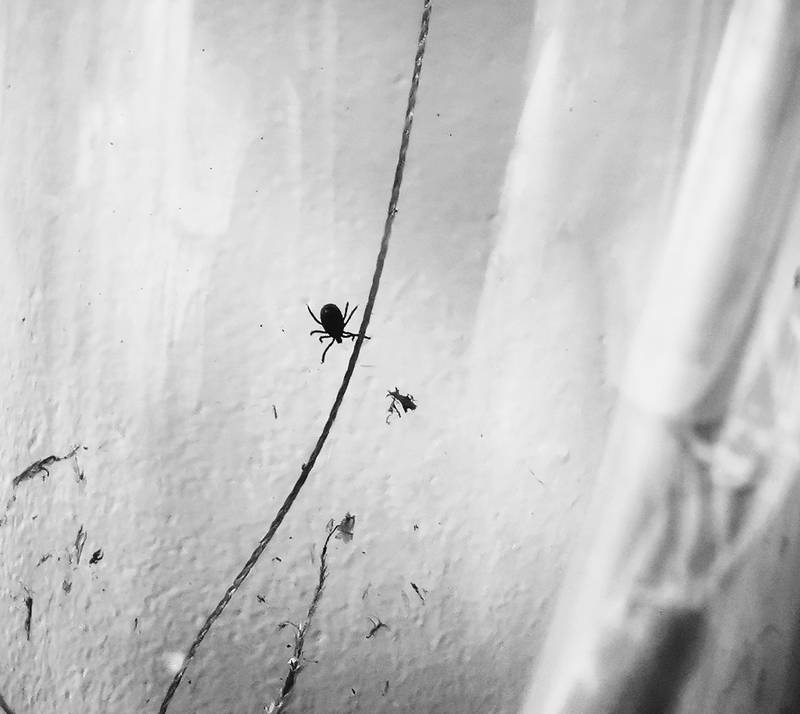

TICK ACTs. Photo courtesy Laura Beloff.
